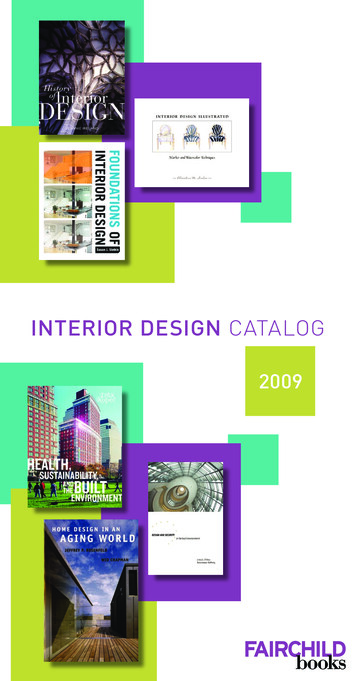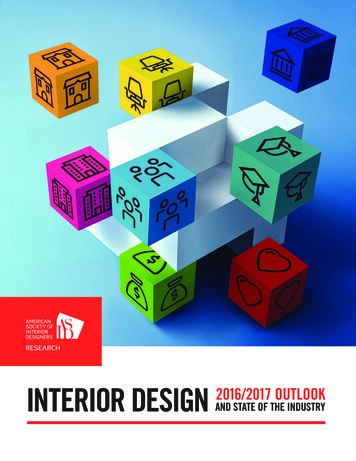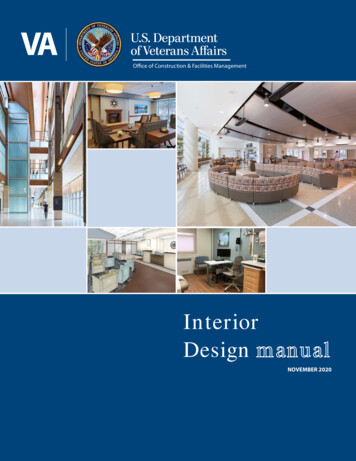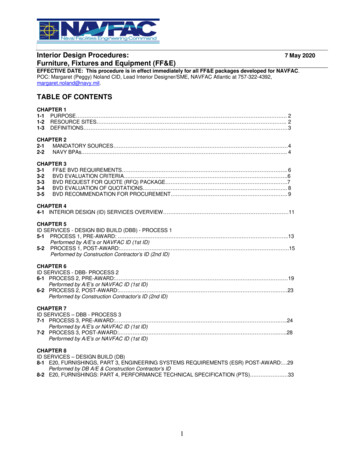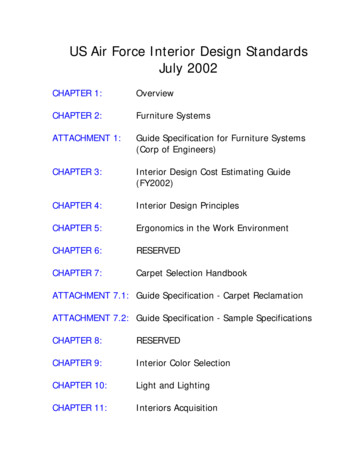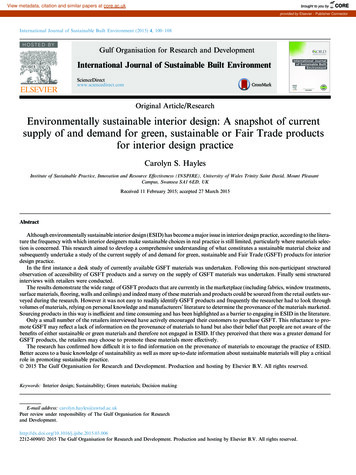
Transcription
View metadata, citation and similar papers at core.ac.ukbrought to you byCOREprovided by Elsevier - Publisher ConnectorInternational Journal of Sustainable Built Environment (2015) 4, 100–108H O S T E D BYGulf Organisation for Research and DevelopmentInternational Journal of Sustainable Built nal Article/ResearchEnvironmentally sustainable interior design: A snapshot of currentsupply of and demand for green, sustainable or Fair Trade productsfor interior design practiceCarolyn S. HaylesInstitute of Sustainable Practice, Innovation and Resource Effectiveness (INSPIRE), University of Wales Trinity Saint David, Mount PleasantCampus, Swansea SA1 6ED, UKReceived 11 February 2015; accepted 27 March 2015AbstractAlthough environmentally sustainable interior design (ESID) has become a major issue in interior design practice, according to the literature the frequency with which interior designers make sustainable choices in real practice is still limited, particularly where materials selection is concerned. This research aimed to develop a comprehensive understanding of what constitutes a sustainable material choice andsubsequently undertake a study of the current supply of and demand for green, sustainable and Fair Trade (GSFT) products for interiordesign practice.In the first instance a desk study of currently available GSFT materials was undertaken. Following this non-participant structuredobservation of accessibility of GSFT products and a survey on the supply of GSFT materials was undertaken. Finally semi structuredinterviews with retailers were conducted.The results demonstrate the wide range of GSFT products that are currently in the marketplace (including fabrics, window treatments,surface materials, flooring, walls and ceilings) and indeed many of these materials and products could be sourced from the retail outlets surveyed during the research. However it was not easy to readily identify GSFT products and frequently the researcher had to look throughvolumes of materials, relying on personal knowledge and manufacturers’ literature to determine the provenance of the materials marketed.Sourcing products in this way is inefficient and time consuming and has been highlighted as a barrier to engaging in ESID in the literature.Only a small number of the retailers interviewed have actively encouraged their customers to purchase GSFT. This reluctance to promote GSFT may reflect a lack of information on the provenance of materials to hand but also their belief that people are not aware of thebenefits of either sustainable or green materials and therefore not engaged in ESID. If they perceived that there was a greater demand forGSFT products, the retailers may choose to promote these materials more effectively.The research has confirmed how difficult it is to find information on the provenance of materials to encourage the practice of ESID.Better access to a basic knowledge of sustainability as well as more up-to-date information about sustainable materials will play a criticalrole in promoting sustainable practice.Ó 2015 The Gulf Organisation for Research and Development. Production and hosting by Elsevier B.V. All rights reserved.Keywords: Interior design; Sustainability; Green materials; Decision makingE-mail address: carolyn.hayles@uwtsd.ac.ukPeer review under responsibility of The Gulf Organisation for Researchand .03.0062212-6090/Ó 2015 The Gulf Organisation for Research and Development. Production and hosting by Elsevier B.V. All rights reserved.
C.S. Hayles / International Journal of Sustainable Built Environment 4 (2015) 100–1081. Introduction1.1. Transitioning to sustainable designTraditionally the interior design profession has concerned itself with a one-dimensional practice, to provideaesthetic enhancements to an interior space for a client(Cargo, 2013). Indeed, Yang et al. (2011) describe traditional interior design as relatively backward and conservative, only focusing on fashion, luxury design insmall environments; an approach that ignores energy savings and emissions reduction, as well as the harmful effectson consumers’ mental and physical health, and environmental pollution (Yang et al., 2011).However in recent years interior design practice has seena dramatic shift with design strategies that now focus onproviding healthy and sustainable environments forindividual’s to live, work and play in (Bonda andSosnowchick, 2007). Society is beginning to recognise theinterconnectedness of buildings, people and communityin the creation of an environmentally responsible builtenvironment; clients are beginning to understand their roleand impact on the environment. As a result they are seeking interiors that demonstrate environmentally responsible,sustainable design (Mazarella et al., 2011; Cargo, 2013).This interest in environmental responsibility is what hassparked the context and need for environmentally sustainable interior design (ESID) (Jones, 2008).1.2. Environmentally sustainable interior design (ESID)ESID is based on the sustainable design principles andstrategies common to the built environment as a whole,namely providing physiologically and psychologicallyhealthy indoor environments (Fisk and Rosenfeld, 1997;Kang and Guerin, 2009).Often the terms green and sustainable are used interchangeably in design. However it is necessary to providea distinction between the two. In this paper, green designrefers to a focus on people issues – their health, safetyand welfare; whilst sustainable design encompasses a moreglobal approach – the health, safety and welfare of the planet, so that it is possible for this generation to meet theirneeds without jeopardising the ability of future generationsto meet their own needs (World Commission onEnvironment and Development, 1987). In addition it isappropriate to consider Fair-trade goods, aimed at helpingproducers in developing countries achieve better trade conditions and to promote sustainability. There is a focus ongetting a better price, decent working conditions and fairterms of trade for farmers and workers worldwide(Fairtrade Foundation, 2014).The term ESID encompasses all three concepts and it isthe responsibility of those charged with creating interiorspaces in the built environment to implement ESID in bothnew-build and in the renovation/retrofit of existingbuildings.101In order to achieve this a holistic approach is required,‘one in which all systems and materials are designed withan emphasis on integration into a whole, for the purposeof minimising negative impacts on the environment andoccupant and maximising positive impacts on environment, economic and social systems over the life cycle of aproject’ (Kang and Guerin, 2009 p.180).Therefore, in comparison with traditional design practices, where designers are primarily focussed on meetingthe clients’ aesthetic and functional needs, ESID focuseson the materials’ intended application, aesthetic qualities,environmental and health impacts, availability, ease ofinstalment and maintenance, and initial and life cycle costs(Cargo, 2013; Moussatche et al., 2002; Pile, 2003).Although ESID has become a major issue in interiordesign practice, according to the literature the frequencywith which interior designers make sustainable choices inreal practice is still limited (e.g. Cargo, 2013; Kusumariniet al., 2011; Kang and Guerin, 2009). This ‘sustainabilitygap’, as described by Steig (2006), is the disparity thatexists between the principles of ESID and the reality ofpractice. It is characterised by a lack of connection madeby designers between their practice and the resultingenvironmental impacts of that practice (Steig, 2006).1.3. Aims and objectivesAs a result, the aim of this research project was to firstdevelop a comprehensive understanding of what constitutes a sustainable or green material choice and subsequently undertake a study to ascertain a snapshot ofcurrent supply of and demand for green, sustainable orFair Trade (GSFT) products for interior design practice.2. Literature review2.1. Materials selectionA number of factors should have led to increased interest, specification and purchasing of sustainable materialsand products. These include a greater awareness of andsensitivity towards the World’s limited natural resources;a growing demand for healthier, more energy-efficientand environmentally responsible homes and work places;the establishment of Green Building Councils and theirpromotion of policies and programmes aided to implementgreen building projects, such as BRE’s EnvironmentalAssessment Method (BREEAM), Code for SustainableHomes (CSH), Leadership in Energy and EnvironmentalDesign (LEED), Green Star rating systems; municipalitiesoffering incentives to ‘go green’, such as tax credits forthe construction of buildings that are environmentallyresponsible; and e.g. Environmental Protection Agenciestaking on more of a leadership role in actively mandatinggreener building policies.However, although there are several groups disseminating information regarding green and sustainable materials
102C.S. Hayles / International Journal of Sustainable Built Environment 4 (2015) 100–108(e.g. the Forestry Stewardship Council (FSC) and‘OneWool’ from the British Wool Marketing Board), noone is focussing on developing a comprehensive understanding of environmentally responsible materials (Jones,2008).Materials selection has a high impact on the sustainable outcome of all interior design projects but in particular commercial interior design projects, which aregenerally ‘churned’ every 5–7 years, placing a heavy burden on resources and creating large amounts of waste(Maté, 2009). As a result of churning, the embodiedenergy of the furniture, fixtures and fittings can outweighthe operational energy costs of an office building over aforty-year life span (Trelour et al., 1999). Clearly thereare heavy costs associated with the selection of unsustainable materials.This lack of focus on interiors has created an information void for architects, interior designers and facilitiesmanagers who want to specify environmentally responsiblefurnishing, finishes and equipment for interior environments. Many interior designers have limited knowledgeabout the adverse properties of the materials they specify(Guerin and Ginthner, 1999).Interior furnishings, materials and finishes require significant quantities of natural resources for their extraction,transport, processing, reuse, recycling and disposal(California Integrated Waste Management Board, 2002).By integrating environmentally sustainable materials intobuilding projects, it is possible to significantly reduceenvironmental impacts through less energy consumption,less natural resource depletion and pollution, plus less toxicity for both the occupants and the entire ecosystem. Theseboth minimise the negative impacts on the environmentand occupants whilst maximising positive impacts overthe lifecycle of a building (Araji and Shakour, 2013;Kang and Guerin, 2009).2.2. Barriers to sustainable materials selectionLittle research has yet focused on interior designers’choices of sustainable materials (Lee et al., 2013) and thosethat have demonstrated on the whole that sustainablematerials selection is not a priority. Client resistance, perceived cost, lack of expertise and knowledge of materials,limited materials selection and authenticity of suppliers,time to source materials, understanding of the impact ofmaterials, accurate and accessible information and appropriate tools have all been nominated as barriers to theadoption of ESID (Hes, 2005; Davis, 2001; Kang andGuerin, 2009; Maté, 2006; Aye, 2003; Hankinson andBreytabace, 2012; Jones, 2008).According to research undertaken by Maté (2009) costwas considered the biggest barrier for those who were notready to take the responsibility for sustainable practice orwho followed sustainable practice only where required,whilst the cost was not a significant barrier for those whowere proactive in sustainable practice (Maté, 2009).In Hankinson and Breytabace’s (2012) study three concerns were raised when considering the specification of sustainable materials namely: the reliability of informationfrom product suppliers and manufacturers e.g. green washing;1 limited selection of environmentally responsible materials; and the need to rely on imported materials (with highembodied energy due to transportation) versus locally produced materials (Hankinson and Breytabace, 2012).A survey conducted by Moussatche et al. (2002) showedthat interior designers select materials primarily accordingto clients’ preferences, needs, aesthetics and cost, not considering sustainability as a criterion. This research, in linewith research undertaken by Kang and Guerin (2009),found that the efforts to gain knowledge about sustainablematerials and products was considered too time consumingfor the pressures of the designers’ schedules. As a result fastand easy access to materials’ data was considered animportant factor in materials choice and those surveyedwere found to heavily rely on manufacturers’ literaturebecause of its accessibility.More specifically, Moussatche et al. (2002) found thatfunctional factors, such as durability and maintenancewere considered by participants in their study to be important criteria whilst global impact was commonly listed assecondary criteria. Health factors such as volatile organiccompound (VOC) emissions, susceptibility to microbiological growth and long-term environmental impact werenot a significant criterion for choosing materials(Moussatche et al., 2002). A similar outcome was recordedby Usal (2012) who looked at the role sustainability playedin the choice of products amongst a group of interiordesign students. This study showed that although studentsperceived durability to be important, they were more concerned about trends and fashion than sustainability (Usal,2012).However, Maté’s (2006) survey of designers in Sydney,Australia, found evidence that the designers’ values werea greater determining factor when it came to selection ofsustainable materials. Those who championed ESID displayed certain attributes and behaviours, which includedquestioning the authenticity of eco-materials. They wereless likely to see cost as a barrier, and more likely to consider the importance of sustainable qualities in materialsselection (Maté, 2006). In line with Maté’s findings, Leeet al. (2013) found that interior designers with a positiveattitude towards the adoption of sustainable materials ledto their stronger behaviour contention to adopt such materials. The results suggest the importance of developinginterior designers’ positive environmental attitudes (Leeet al., 2013).Cargo (2013) examined interior design practitioners’ useof environmentally sustainable material selection1With their fervour to market their products, some manufacturers haveindulged in ‘green washing’ i.e. exaggerated the green or sustainablecharacteristics of their products; making it difficult for designers who wantto practice ERID to see the ‘wood for the trees’, especially if they are notthemselves immersed in ESID language (Jones, 2008).
C.S. Hayles / International Journal of Sustainable Built Environment 4 (2015) 100–108databases. Although interior designers indicated that theyplace a high value on sustainability and felt a strong moralobligation to provide ESID spaces to clients, Cargo’sresearch found that they were not acting on these due tolack of awareness of materials selection databases that helpreduce the majority of the complexity from designingenvironmentally responsible schemes. Cargo (2013) suggests that a lack of motivation amongst interior designersto research new sustainable materials and products is causing the existing materials selection databases to be underutilised; barriers must be addressed in order to take fulladvantage of all sustainable materials and products offered(Cargo, 2013).It is essential that product designers and manufacturerscontinue developing environmentally responsible productsand broaden their product ranges, as with greater selection,designers and clients are more likely to choose this alternative. Also, designers need to continually ask product suppliers and manufacturers about their raw materials,processes and the origin of products (Hankinson andBreytabace, 2012).The studies outlined above demonstrate the need for agreater focus to be placed on education and CPD forESID for designers and clients alike; and in particular sustainable materials selection within design practices. ESID isbeginning to become more prevalent within the field, but itis clear that challenges and barriers are preventing interiordesigner professionals from completely converting to this‘new’ sustainable design practice (Cargo, 2013).3. Research methodologyThe aim of this research project was to first develop acomprehensive understanding of what constitutes a sustainable or green material choice and subsequently undertake a study to ascertain a snapshot of current supply ofand demand for GSFT products for interior designpractice.Research was undertaken using four research methods:1. Desk study of currently available GSFT materials;2. Non-participant structured observation of accessibilityof GSFT products;3. Survey on the supply of GSFT materials to designersand public; and4. Semi structured interviews with retailers.1. A desk study was conducted to determine whatmaterials are considered to be sustainable and green. It alsoallowed the researcher to categorise materials according totheir application. This form of secondary research involvedcollecting data from existing resources. It provided a usefultool to support the primary research of the study, as well asbeing time and cost effective (Stewart and Kamins, 1993).2. Non-participant structured observation within retailoutlets (n 30) that supply materials for interior designprojects was undertaken in order to determine accessibility103of GSFT materials.2 In this study a selected sample ofretailers, who are based in a high profile design retail centreused by both designers and public, was considered moreappropriate than a random sample because of the natureof the study i.e. to establish current supply of and demandfor GSFT products (Naoum, 2013). As a result storeswhose stock focussed on material sales (as opposed toe.g. lighting) were targeted. The final sample was n 30of a total of n 86 retail outlets (35% of the total numberof outlets).3. A survey of the current availability of GSFT productswas conducted in (n 30) retail units that supply materialsfor interior design projects. The desk study results wereused to categorise GSFT products for analysis. All stockwas surveyed to establish whether or not there were anyGSFT products for sale, and if so, what categories wererepresented.4. Semi structured interviews with a mix of open andclosed questions were conducted with retailers (n 30) todetermine their knowledge of GSFT materials as well asclient demand for GSFT materials. Retailers were askedif they stocked GSFT products. If the answer was ‘yes’ theywere asked to describe their attributes. If the answer was‘No’ and they did stock GSFT items, they were shownthe products and provided with an explanation as to whythey were considered to be GSFT. If the answer was ‘No’and they do not stock items, they were asked why notand what the barriers might be to stocking GSFT products.They were also asked if customers ever ask for GSFTproducts; whether they believed there was a demand forGSFT; and whether they encouraged customers to purchase GSFT products (if they stocked them). They wereasked if they thought the health benefits of using ‘Green’products or the environmental benefits of using‘Sustainable’ products were widely known. Finally theywere asked what they believed the barriers to customerspurchasing GSFT products were.4. Results4.1. Sustainable and green materialsThe materials’ uses being considered in this researchproject fall into five categories:1.2.3.4.5.2Fabrics;Window treatments;Surface materials;Flooring; andWalls and ceilings.Observation is an important aspect of action research and can bestructured or unstructured, participant or not participant, over or covert.In this research a non-participant structured approach was adopted. Thisapproach was adopted because it has been known to limit subjectivity andobserver bias whilst enhancing validity and the overall reliability of theresults (Hannon, 2006; Gerrish and Lacey, 2010 in R1; Merriam, 1998;Angrosino and Mays dePerez, 2000).
104C.S. Hayles / International Journal of Sustainable Built Environment 4 (2015) 100–1084.1.1. FabricsResearch has revealed that it is necessary to consider thefollowing when determining whether or not a fabric can beconsidered green or sustainable.1. Chemicals: Is the fabric and its manufacturing processfree of harmful chemicals: Any of 2000 chemicals canbe used during the manufacturing process, leaving residual amounts in the fabric that can leach into the watersupply, pollute the air, and be absorbed by human skin;2. Renewable: Is it from a renewable source: If it is a synthetic fibre, is it 100% recyclable and made from recycledcontent material; or is it antique;3. Animal by-products: Has the hide been purchased from afarm that is free range;4. Longevity: How long will the fabric be useable beforeit shows signs of wear and needs to be replaced? Themore durable a fabric is, the longer it will last, and along-lasting fabric can be considered as more environmentally friendly than one that must be replaced frequently; and5. Biodegradable: Is the fabric biodegradable, and if so isthere an alternative option to becoming part of thewaste stream at the end of its useful life.Fabrics can be made from plant fibres, animal fibres,and synthetic fibres.Green and sustainable plant fibres include: Organic cotton;Organic linen;Bamboo;Agave;Nettle;Hemp;Seacell;Soy fibre;Lyocell; andBark cloth.Green and sustainable animal fibres include: Wool;Cashmere;Alpaca;Camel hair;Leather; andSilk.Although many synthetic fabrics are made from petroleum-based product, they can still be considered green.Some synthetic fabrics are spun from recycled pre- andpost-consumer materials, like plastic bottles and wastefrom industrial production. This diverts waste from landfills and converts it into useful raw materials. Some of theserecycled content fabrics are extremely durable. Even moresustainable are fabrics created from recycled waste, whichcan be recycled into new raw materials when their lifespanis over. These types of synthetics are easily cleaned, fireresistant and contain recycled and recyclable content.4.1.2. Window treatmentsWindow treatments are green by design as they helpcontrol the amount of heat gained and lost throughwindows. Their insulating and light blocking propertieshelp to reduce heating and cooling energy loads. Windowtreatments may be made from: Fabric; Natural grass e.g. flax and hemp have a high resistanceto ultraviolet rays; Bamboo, which has antimicrobial properties that makesit resistant to mould; Wood made from FSC timber in the form of blinds; and Composites made with 100% recyclable and renewablematerials.4.1.3. Surface materialsSelecting green and sustainable products makes a vastimprovement on the effect surface materials have onenvironmental and human health. For example, the reduction or elimination of pollutants significantly improves airquality for both indoor and outdoor environments. This isespecially important for people who suffer from SickBuilding Syndrome.3Examples include recycled glass. However, in order forrecycling to make economic sense, designers will need toactively seek out and purchase materials made withrecycled content. In addition, buying Fair Trade sustainable materials will ensure labourers are not exposed to toxins as well as reduce exploitation.4.1.4. FlooringHard flooring can be made from the following: Wood: FSC wood, reclaimed wood; Fast growing and renewable materials: cork, bamboo,linoleum, recycled rubber; Natural stone; Tile or terrazzo: made from pre or post-consumerrecycled content; and Finished in situ concrete.Carpets can be made from wool, organic cotton, bamboo, hemp and jute, whilst their underlay can be madefrom recycled content. Carpet tiles can also be made fromrecycled content and it is possible to refurbish carpets.3Common to many buildings with Sick Building Syndrome (SBS) is theuse of interior materials that have exposed the occupants to both chemicaland microbial pollutants (McMullan, 2007).
C.S. Hayles / International Journal of Sustainable Built Environment 4 (2015) 100–1084.1.5. Walls and ceilings Paint: non VOC paint e.g. water based and clay paints; Tile: recycled tiles come in glass, ceramic and porcelain andfrom recycled glass and pre-consumer industrial waste; Plaster: earth-based plasters are the healthiest wall finishes – natural clay plaster allows a wall to absorb andrelease moisture as needed; Wall covers: papers made from rapidly renewablesources like cork, grasses and other plant fibres, butmust be used with an environmentally friendly glue orpaste; Faux stone: manufactured using recycled water in themanufacturing process and sourcing local raw materialsmade with pre and post-consumer waste products; and Wall panels: made from eco-friendly materials – nontoxic recycled or rapidly renewable materials are all used(Dennis, 2010; Nayar, 2009; Howarth and Reid, 2000;Jones, 2008; Pilatowicz, 1995).Databases of materials such as those found at ding-databasesdesign-resources/ can help with sourcing suitable productsand materials.4.2. ObservationNon-participant structured observation of each retailoutlet (n 30) was undertaken to determine the ease withwhich GSFT products could be identified from stock.Other than in the retail outlet that only sold Fair Tradegoods, it was not easy to identify GSFT products. In somecases the retailer could not readily identify them either andin those instances the researcher had to explain what theywere looking for. In particular when looking at fabric samples it was necessary to sort through a lot of stock, referring to the manufacturers’ information, to determinewhether or not the material could be considered GSFT.However a small number of retailers were confidentidentifying GSFT materials, highlighting their GSFT credentials to generate interest in the product.1053. Low VOC paints;4. FSC and rapid renewables in floor covering, wall coverings and fabric blends; and5. Fair Trade: both retailers selling readily identifiable FairTrade products were companies selling floor coverings.Fig. 1 shows the frequency of materials categorisedaccording to their application, with some suppliers offeringmore than one product, whilst Fig. 2 identifies their GSFTattributes, with some products exhibiting more than oneGSFT attribute.4.4. Semi structured interviewsEach of the retailers (n 30) was asked whether or notthey stocked GSFT products. 60% (n 18) stated that theydid and were able to identify particular products, whilst30% (n 9) did not stock any identifiable GSFT products.10% (n 3) did stock GSFT products but the retailersinterviewed were unaware of this. As a result it was necessary for the researcher to provide an explanation and identify GSFT products stocked in their retail outlets.When asked whether or not customers ever ask forGSFT products when they came into the store, 13% ofretailers (n 4) stated that they had been specifically askedto recommend GSFT products, whilst 67% (n 20) couldnot recall being asked specifically about GSFT but mayhave been asked about a particular material that hadGSFT properties, and 20% (n 6) stated categorically thatno one had ever inquired about GSFT products.Walls and ceilings8Flooring3Surface materials5Window treatments12Fabrics14Fig. 1. GSFT application.4.3. SurveyA survey of (n 30) suppliers of materials to designersand public established that 70% (n 21) of suppliersstocked identifiable GSFT material products.Examples of GSFT materials found included thefollowing:1. Plant and animal fibres: organic cotton, bamboo andhemp. Velvet, bamboo and cotton-blended fabrics, bamboo, arrowroot and sisal wall coverings, leather floorcoverings;2. Synthetic fibres and recycled content: recycled ceramic,porcelain and glass tiles; recycled polyesters, eco-vinyland blended ‘wool’ made from recycled materials;Fair Trade2Rapid renewables6Non/Low VOC8Recycled content6Synthe c fibres4Animal fibres2Plant fibres12FSC mber202468Fig. 2. GSFT attributes.101214
106C.S. Hayles / International Journal of Sustainable Built Environment 4 (2015) 100–108When asked whether or not they believe there is currently a demand for GSFT in the marketplace, 33%(n 10) said ‘yes’, 17% said ‘no’ (n 5) and 20% (n 6)said ‘not yet’ stating that purchasers do not consider theprovenance of the materials they chose and were unawareof issues such as VOCs.Of the 70% (n 21) stockists of GSFT, only 10% (n 3)said that they would actively encourage customers to purchase GSFT products, with 53% (n 16) saying no, and7% (n 2) saying that they may mention it depending onthe situation and level of interaction with the client addingthat “specifying green or sustainable materials is notstraight forward” and “I rely on manufacturers’information”.Retailers do not believe the health benefits of usinggreen products are widely known, with a resounding 93%(n 28) saying no and 7% (n 2) saying only in certaincircles e.g. designers specifying materials for health andeducation facilities. When asked if they believe the environmental benefits of using sustainable products are widelyknown, 83% (n 25) said no and 17% (n 5) say yes,and in particular as a result of initiatives aimed at promoting awareness amongst the general public.When a
Traditionally the interior design profession has con-cerned itself with a one-dimensional practice, to provide aesthetic enhancements to an interior space for a client (Cargo, 2013). Indeed, Yang et al. (2011) describe tradi-tional interior design as relatively backward and con-servative, on


